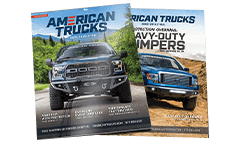3 Days Left! Guaranteed Free Delivery 12/24. Order by 3pm EST available on most items - Details
How to Install a Rough Country 2.5-inch Strut Leveling Lift Kit w/shocks on your Ford F-150
Installation Time
3 hours
Tools Required
- 15mm Wrench
- 15mm Socket
- 29mm Socket
- 1 1/16” Wrench
- 21mm Wrench
- 16 mm Wrench
- 21 mm Wrench
- 3/8” mm Wrench
- 9/16” Wrench
- 9/16” Socket
- Hammer
- Floor Jack
- Jack Stands
- 2-Front Strut Extensions
- 1-Kit Bag that includes
- 6-10mm Washers
- 6-10mm Lock Nuts

Shop Parts in this Guide
INSTALLATION INSTRUCTIONS
1. Jack up the front of the vehicle and support the vehicle with jack stands, so that the front wheels are off the ground. Next remove the front tires/wheels, using a 21mm deep well socket.
2. Using a 15mm socket remove the front skid if the truck is equipped with a full front skid.
3. On 2011-up models and if equipped, remove the EPAS (Electronic Power Assist Steering) Plugs as shown located on the steering assembly by the front differential. See Photo 1 & 2. This must be done BEFORE installation is started.
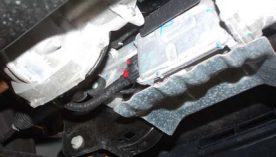
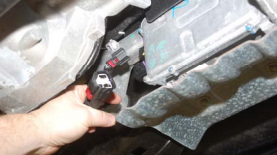
4. Place jack stand under the knuckle for support. Remove nut, using a 21mm wrench. Using a hammer hit the knuckle as shown to allow the ball joint to separate from the upper control arm. See Photo 3. Do not allow the knuckle to pull out far enough that it pulls the shaft out of the differential.
5. Using a 21mm wrench remove the nut from the steering linkage. Using a hammer hit on the side of the knuckle as shown, where the steering linkage is connected and remove from knuckle. Push linkage forward to make room for installation. Retain factory hardware. See Photo 4.
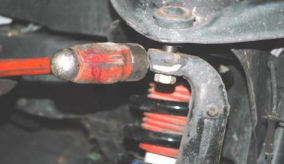
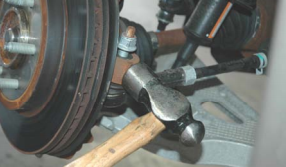
6. Remove the sway bar nut and bushings using a 15mm wrench. Retain factory hardware. See Photo 5.
7. Using a 15mm wrench, remove the nuts on the upper strut tower that holds the assembly in place. See Photo 6. One nut can be left on the upper bolts to hold the strut in place.

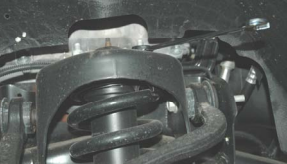
8. On 04-13 models using a 29mm socket, and 1 1/16”, wrench, remove the strut bolt from the lower control arm and remove the strut assembly from the vehicle. Retain the factory lower bolt for reassembly. Note the direction of the bolt for reassembly. See Photo 7.
9. Looking at the spacer as shown in Photo 9 insert the stud through the back side of the spacer. Use washers and nut to pull the stud into place. For 09-13 models you will have one (A) driver side spacer and one (B) passenger side spacer. When installing the spacers both sides will have the RC logo to the outside.
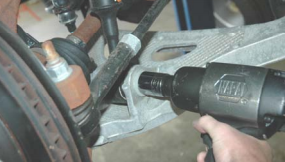
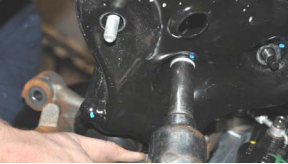
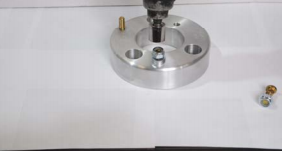
10. Install the new strut spacer on the strut, using stock hardware and 9/16” socket. Torque to 30 ft/lbs. See Photo
11. Install the strut assembly into the strut tower and secure with the supplied 10mm lock nuts using a 17mm wrench. Torque to 30 ft/lbs.
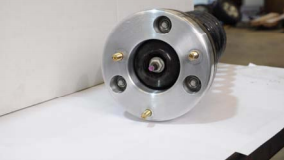
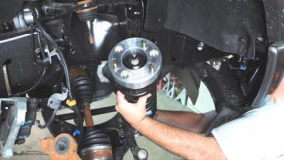
11. On 04-13 models install the lower strut bolt in the original position that it was removed. Using a 29mm socket, and 1 1/16” wrench, torque to factory specs. See Photo 13.
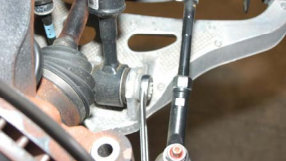
12. Using a floor jack, raise the lower control arm and connect the upper ball joint on the upper control arm to the spindle. Using a 21mm wrench, torque to manufacturer specs. If ball joint turns while tightening, use a 3/8”
wrench to hold the ball joint.
13. Reinstall the steering linkage nut using a 21mm wrench.
14. Repeat steps 3-13 on opposite side of vehicle.
15. Using a 15mm wrench, reinstall sway bar bushings and nut using factory hardware. Torque to factory specs.
16. Install the wheels / tires, using a 21mm deep well socket.
17. If removed, reconnect the EPAS plugs.
18. Jack up the vehicle and remove the jack stands. Lower the vehicle to the floor and torque all bolts to factory specifications.
19. Vehicle will have to have a front-end alignment.
20. If the rear block kit & shocks was ordered with the kit please proceed to the next section.
REAR INSTALLATION INSTRUCTIONS
1. Chock the front wheels.
2. Jack up the rear of the vehicle and place jack stands underneath the frame rail.
3. Remove the tires and wheels.
4. Remove rear shocks using a 15mm, and 18mm wrench. Save the stock hardware it will be used later.
5. Place the floor jack underneath the axle and remove the stock u-bolts. Lower the axle down to allow the blocks to be installed in between the stock block and the spring perch. Install the new u-bolts and secure with fasteners
provided.
6. Assemble the rear shocks 658694, and install in the stock position with stock hardware, using a 15mm and 18mm wrench. Note: N2.0 shock absorbers are designed to run with the body of the shock absorber on the axle mount and the piston rod on the frame end.
POST INSTALLATION INSTRUCTIONS
1. Check all fasteners for proper torque. Check to ensure there is adequate clearance between all rotating, mobile, fixed and heated members. Check steering for interference and proper working order. Test brake system.
2. Perform steering sweep. The distance between the tire sidewall and the brake hose must be checked closely. Cycle the steering from full turn to full turn to check for clearance. Failure to perform inspections may result in component failure.
3. Re torque all fasteners after 500 miles. Visually inspect components and re torque fasteners during routine vehicle service.
4. Readjust headlights to proper settings.
MAINTENANCE INFORMATION
It is the ultimate buyers responsibility to have all bolts/nuts checked for tightness after the first 500 miles and then every 1000 miles. Wheel alignment steering system, suspension and driveline systems must be inspected by a qualified
professional mechanic at least every 3000 miles
